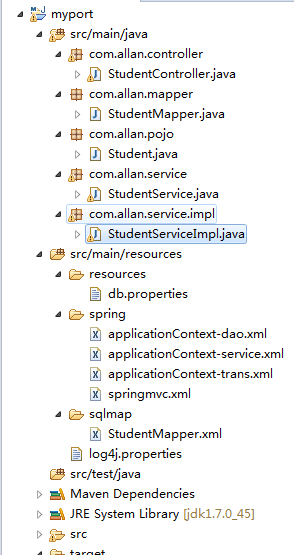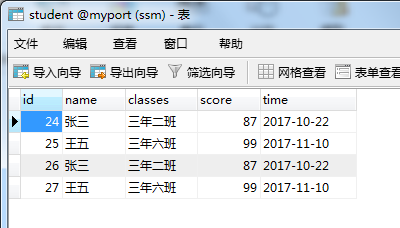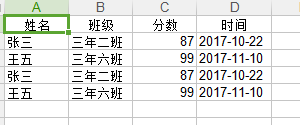一、介紹
利用java實現(xiàn)文件的導(dǎo)入導(dǎo)出數(shù)據(jù)庫,目前在大部分系統(tǒng)中是比較常見的功能了,今天寫個小demo來理解其原理,沒接觸過的同學(xué)也可以看看參考下。
目前我所接觸過的導(dǎo)入導(dǎo)出技術(shù)主要有POI和iReport,poi主要作為一些數(shù)據(jù)批量導(dǎo)入數(shù)據(jù)庫,iReport做報表導(dǎo)出。另外還有jxl類似poi的方式,不過貌似很久沒跟新了,2007之后的office好像也不支持,這里就不說了。
二、POI使用詳解
2.1 什么是Apache POI?
Apache POI是Apache軟件基金會的開放源碼函式庫,POI提供API給Java程序?qū)icrosoft Office格式檔案讀和寫的功能。
2.2 POI的jar包導(dǎo)入
本次講解使用maven工程,jar包版本使用poi-3.14和poi-ooxml-3.14。目前最新的版本是3.16。因為3.15以后相關(guān)api有更新,部分操作可能不一樣,大家注意下。
|
1
2
3
4
5
6
7
8
9
10
11
|
<!-- poi的包 3.15版本后單元格類型獲取方式有調(diào)整 --><dependency> <groupId>org.apache.poi</groupId> <artifactId>poi</artifactId> <version>3.14</version></dependency><dependency> <groupId>org.apache.poi</groupId> <artifactId>poi-ooxml</artifactId> <version>3.14</version></dependency> |
2.3 POI的API講解
2.3.1 結(jié)構(gòu)
- HSSF - 提供讀寫Microsoft Excel格式檔案的功能。
- XSSF - 提供讀寫Microsoft Excel OOXML格式檔案的功能。
- HWPF - 提供讀寫Microsoft Word格式檔案的功能。
- HSLF - 提供讀寫Microsoft PowerPoint格式檔案的功能。
- HDGF - 提供讀寫Microsoft Visio格式檔案的功能。
2.3.2 對象
本文主要介紹HSSF和XSSF兩種組件,簡單的講HSSF用來操作Office 2007版本前excel.xls文件,XSSF用來操作Office 2007版本后的excel.xlsx文件,注意二者的后綴是不一樣的。
HSSF在org.apache.poi.hssf.usermodel包中。它實現(xiàn)了Workbook 接口,用于Excel文件中的.xls格式
常用組件:
HSSFWorkbook excel的文檔對象
HSSFSheet excel的表單
HSSFRow excel的行
HSSFCell excel的格子單元
HSSFFont excel字體
HSSFDataFormat 日期格式
HSSFHeader sheet頭
HSSFFooter sheet尾(只有打印的時候才能看到效果)
樣式:
HSSFCellStyle cell樣式
輔助操作包括:
HSSFDateUtil 日期
HSSFPrintSetup 打印
HSSFErrorConstants 錯誤信息表
XSSF在org.apache.xssf.usemodel包,并實現(xiàn)Workbook接口,用于Excel文件中的.xlsx格式
常用組件:
XSSFWorkbook excel的文檔對象
XSSFSheet excel的表單
XSSFRow excel的行
XSSFCell excel的格子單元
XSSFFont excel字體
XSSFDataFormat 日期格式
和HSSF類似;
2.3.3 兩個組件共同的字段類型描述
其實兩個組件就是針對excel的兩種格式,大部分的操作都是相同的。
|
1
2
3
4
5
6
7
|
單元格類型 描述CELL_TYPE_BLANK 代表空白單元格CELL_TYPE_BOOLEAN 代表布爾單元(true或false)CELL_TYPE_ERROR 表示在單元的誤差值CELL_TYPE_FORMULA 表示一個單元格公式的結(jié)果CELL_TYPE_NUMERIC 表示對一個單元的數(shù)字?jǐn)?shù)據(jù)CELL_TYPE_STRING 表示對一個單元串(文本) |
2.3.4 操作步驟
以HSSF為例,XSSF操作相同。
首先,理解一下一個Excel的文件的組織形式,一個Excel文件對應(yīng)于一個workbook(HSSFWorkbook),一個workbook可以有多個sheet(HSSFSheet)組成,一個sheet是由多個row(HSSFRow)組成,一個row是由多個cell(HSSFCell)組成。
1、用HSSFWorkbook打開或者創(chuàng)建“Excel文件對象”
2、用HSSFWorkbook對象返回或者創(chuàng)建Sheet對象
3、用Sheet對象返回行對象,用行對象得到Cell對象
4、對Cell對象讀寫。
三、代碼操作
3.1 效果圖
慣例,貼代碼前先看效果圖
Excel文件兩種格式各一個:


代碼結(jié)構(gòu):

導(dǎo)入后:(我導(dǎo)入了兩遍,沒做校驗)

導(dǎo)出效果:

3.2 代碼詳解
這里我以Spring+SpringMVC+Mybatis為基礎(chǔ)
Controller:
|
1
2
3
4
5
6
7
8
9
10
11
12
13
14
15
16
17
18
19
20
21
22
23
24
25
26
27
28
29
30
31
32
33
34
35
36
37
38
39
40
41
42
43
44
45
46
47
48
49
50
51
52
53
54
55
56
57
58
59
60
61
62
|
package com.allan.controller;import java.util.List;import javax.servlet.http.HttpServletResponse;import org.apache.poi.ss.formula.functions.Mode;import org.springframework.beans.factory.annotation.Autowired;import org.springframework.stereotype.Controller;import org.springframework.ui.Model;import org.springframework.web.bind.annotation.RequestMapping;import org.springframework.web.bind.annotation.RequestMethod;import org.springframework.web.bind.annotation.RequestParam;import org.springframework.web.bind.annotation.ResponseBody;import org.springframework.web.multipart.MultipartFile;import org.springframework.web.servlet.ModelAndView;import com.allan.pojo.Student;import com.allan.service.StudentService;/** * * @author 小賣鋪的老爺爺 * */@Controllerpublic class StudentController { @Autowired private StudentService studentService; /** * 批量導(dǎo)入表單數(shù)據(jù) * * @param request * @param myfile * @return */ @RequestMapping(value="/importExcel",method=RequestMethod.POST) public String importExcel(@RequestParam("myfile") MultipartFile myFile) { ModelAndView modelAndView = new ModelAndView(); try { Integer num = studentService.importExcel(myFile); } catch (Exception e) { modelAndView.addObject("msg", e.getMessage()); return "index"; } modelAndView.addObject("msg", "數(shù)據(jù)導(dǎo)入成功"); return "index"; } @RequestMapping(value="/exportExcel",method=RequestMethod.GET) public void exportExcel(HttpServletResponse response) { try { studentService.exportExcel(response); } catch (Exception e) { e.printStackTrace(); } } } |
Service
|
1
2
3
4
5
6
7
8
9
10
11
12
13
14
15
16
17
18
19
20
21
22
23
24
25
26
27
28
29
30
31
32
33
34
35
36
37
38
39
40
41
42
43
44
45
46
47
48
49
50
51
52
53
54
55
56
57
58
59
60
61
62
63
64
65
66
67
68
69
70
71
72
73
74
75
76
77
78
79
80
81
82
83
84
85
86
87
88
89
90
91
92
93
94
95
96
97
98
99
100
101
102
103
104
105
106
107
108
109
110
111
112
113
114
115
116
117
118
119
120
121
122
123
124
125
126
127
128
129
130
131
132
133
134
135
136
137
138
139
140
141
142
143
144
145
146
147
148
149
150
151
152
153
154
155
156
157
158
159
160
161
162
163
164
165
166
167
168
169
170
171
172
173
174
175
176
177
178
179
180
181
182
183
184
185
186
187
188
189
190
191
192
193
194
195
196
197
198
199
200
201
|
package com.allan.service.impl;import java.io.OutputStream;import java.text.DecimalFormat;import java.text.SimpleDateFormat;import java.util.Date;import java.util.List;import javax.servlet.http.HttpServletResponse;import org.apache.commons.lang.StringUtils;import org.apache.poi.hssf.usermodel.HSSFCell;import org.apache.poi.hssf.usermodel.HSSFCellStyle;import org.apache.poi.hssf.usermodel.HSSFDateUtil;import org.apache.poi.hssf.usermodel.HSSFRow;import org.apache.poi.hssf.usermodel.HSSFSheet;import org.apache.poi.hssf.usermodel.HSSFWorkbook;import org.apache.poi.ss.usermodel.Cell;import org.apache.poi.ss.usermodel.Row;import org.apache.poi.ss.usermodel.Sheet;import org.apache.poi.ss.usermodel.Workbook;import org.apache.poi.xssf.usermodel.XSSFWorkbook;import org.springframework.beans.factory.annotation.Autowired;import org.springframework.stereotype.Service;import org.springframework.web.multipart.MultipartFile;import com.allan.mapper.StudentMapper;import com.allan.pojo.Student;import com.allan.service.StudentService;/** * * @author 小賣鋪的老爺爺 * */@Servicepublic class StudentServiceImpl implements StudentService{ private final static String XLS = "xls"; private final static String XLSX = "xlsx"; @Autowired private StudentMapper studentMapper; /** * 導(dǎo)入Excel,兼容xls和xlsx */ @SuppressWarnings("resource") public Integer importExcel(MultipartFile myFile) throws Exception { // 1、用HSSFWorkbook打開或者創(chuàng)建“Excel文件對象” // // 2、用HSSFWorkbook對象返回或者創(chuàng)建Sheet對象 // // 3、用Sheet對象返回行對象,用行對象得到Cell對象 // // 4、對Cell對象讀寫。 //獲得文件名 Workbook workbook = null ; String fileName = myFile.getOriginalFilename(); if(fileName.endsWith(XLS)){ //2003 workbook = new HSSFWorkbook(myFile.getInputStream()); }else if(fileName.endsWith(XLSX)){ //2007 workbook = new XSSFWorkbook(myFile.getInputStream()); }else{ throw new Exception("文件不是Excel文件"); } Sheet sheet = workbook.getSheet("Sheet1"); int rows = sheet.getLastRowNum();// 指的行數(shù),一共有多少行+ if(rows==0){ throw new Exception("請?zhí)顚憯?shù)據(jù)"); } for (int i = 1; i <= rows+1; i++) { // 讀取左上端單元格 Row row = sheet.getRow(i); // 行不為空 if (row != null) { // **讀取cell** Student student = new Student(); //姓名 String name = getCellValue(row.getCell(0)); student.setName(name); //班級 String classes = getCellValue(row.getCell(1)); student.setClasses(classes); //分?jǐn)?shù) String scoreString = getCellValue(row.getCell(2)); if (!StringUtils.isEmpty(scoreString)) { Integer score = Integer.parseInt(scoreString); student.setScore(score); } //考試時間 SimpleDateFormat sdf = new SimpleDateFormat("yyyy-MM-dd");//小寫的mm表示的是分鐘 String dateString = getCellValue(row.getCell(3)); if (!StringUtils.isEmpty(dateString)) { Date date=sdf.parse(dateString); student.setTime(date); } studentMapper.insert(student); } } return rows-1; } /** * 獲得Cell內(nèi)容 * * @param cell * @return */ public String getCellValue(Cell cell) { String value = ""; if (cell != null) { // 以下是判斷數(shù)據(jù)的類型 switch (cell.getCellType()) { case HSSFCell.CELL_TYPE_NUMERIC: // 數(shù)字 value = cell.getNumericCellValue() + ""; if (HSSFDateUtil.isCellDateFormatted(cell)) { Date date = cell.getDateCellValue(); if (date != null) { value = new SimpleDateFormat("yyyy-MM-dd").format(date); } else { value = ""; } } else { value = new DecimalFormat("0").format(cell.getNumericCellValue()); } break; case HSSFCell.CELL_TYPE_STRING: // 字符串 value = cell.getStringCellValue(); break; case HSSFCell.CELL_TYPE_BOOLEAN: // Boolean value = cell.getBooleanCellValue() + ""; break; case HSSFCell.CELL_TYPE_FORMULA: // 公式 value = cell.getCellFormula() + ""; break; case HSSFCell.CELL_TYPE_BLANK: // 空值 value = ""; break; case HSSFCell.CELL_TYPE_ERROR: // 故障 value = "非法字符"; break; default: value = "未知類型"; break; } } return value.trim(); } /** * 導(dǎo)出excel文件 */ public void exportExcel(HttpServletResponse response) throws Exception { // 第一步,創(chuàng)建一個webbook,對應(yīng)一個Excel文件 HSSFWorkbook wb = new HSSFWorkbook(); // 第二步,在webbook中添加一個sheet,對應(yīng)Excel文件中的sheet HSSFSheet sheet = wb.createSheet("Sheet1"); // 第三步,在sheet中添加表頭第0行,注意老版本poi對Excel的行數(shù)列數(shù)有限制short HSSFRow row = sheet.createRow(0); // 第四步,創(chuàng)建單元格,并設(shè)置值表頭 設(shè)置表頭居中 HSSFCellStyle style = wb.createCellStyle(); style.setAlignment(HSSFCellStyle.ALIGN_CENTER); // 創(chuàng)建一個居中格式 HSSFCell cell = row.createCell(0); cell.setCellValue("姓名"); cell.setCellStyle(style); cell = row.createCell(1); cell.setCellValue("班級"); cell.setCellStyle(style); cell = row.createCell(2); cell.setCellValue("分?jǐn)?shù)"); cell.setCellStyle(style); cell = row.createCell(3); cell.setCellValue("時間"); cell.setCellStyle(style); // 第五步,寫入實體數(shù)據(jù) 實際應(yīng)用中這些數(shù)據(jù)從數(shù)據(jù)庫得到, List<Student> list = studentMapper.selectAll(); for (int i = 0; i < list.size(); i++){ row = sheet.createRow(i + 1); Student stu = list.get(i); // 第四步,創(chuàng)建單元格,并設(shè)置值 row.createCell(0).setCellValue(stu.getName()); row.createCell(1).setCellValue(stu.getClasses()); row.createCell(2).setCellValue(stu.getScore()); cell = row.createCell(3); cell.setCellValue(new SimpleDateFormat("yyyy-MM-dd").format(stu.getTime())); } //第六步,輸出Excel文件 OutputStream output=response.getOutputStream(); response.reset(); long filename = System.currentTimeMillis(); SimpleDateFormat df = new SimpleDateFormat("yyyyMMddHHmmss");//設(shè)置日期格式 String fileName = df.format(new Date());// new Date()為獲取當(dāng)前系統(tǒng)時間 response.setHeader("Content-disposition", "attachment; filename="+fileName+".xls"); response.setContentType("application/msexcel"); wb.write(output); output.close(); } } |
3.3 導(dǎo)出文件api補(bǔ)充
大家可以看到上面service的代碼只是最基本的導(dǎo)出。
在實際應(yīng)用中導(dǎo)出的Excel文件往往需要閱讀和打印的,這就需要對輸出的Excel文檔進(jìn)行排版和樣式的設(shè)置,主要操作有合并單元格、設(shè)置單元格樣式、設(shè)置字體樣式等。
3.3.1 單元格合并
使用HSSFSheet的addMergedRegion()方法
|
1
|
public int addMergedRegion(CellRangeAddress region) |
參數(shù)CellRangeAddress 表示合并的區(qū)域,構(gòu)造方法如下:依次表示起始行,截至行,起始列, 截至列
|
1
|
CellRangeAddress(int firstRow, int lastRow, int firstCol, int lastCol) |
3.3.2 設(shè)置單元格的行高和列寬
|
1
2
3
4
|
HSSFSheet sheet=wb.createSheet();sheet.setDefaultRowHeightInPoints(10);//設(shè)置缺省列高sheet.setDefaultColumnWidth(20);//設(shè)置缺省列寬//設(shè)置指定列的列寬,256 * 50這種寫法是因為width參數(shù)單位是單個字符的256分之一sheet.setColumnWidth(cell.getColumnIndex(), 256 * 50); |
3.3.3 設(shè)置單元格樣式
1、創(chuàng)建HSSFCellStyle
|
1
|
HSSFCellStyle cellStyle=wkb.createCellStyle() |
2、設(shè)置樣式
|
1
2
3
4
5
6
7
8
9
10
11
12
13
14
15
16
17
18
19
20
21
|
// 設(shè)置單元格的橫向和縱向?qū)R方式,具體參數(shù)就不列了,參考HSSFCellStyle cellStyle.setAlignment(HSSFCellStyle.ALIGN_JUSTIFY); cellStyle.setVerticalAlignment(HSSFCellStyle.VERTICAL_CENTER); /* 設(shè)置單元格的填充方式,以及前景顏色和背景顏色 三點注意: 1.如果需要前景顏色或背景顏色,一定要指定填充方式,兩者順序無所謂; 2.如果同時存在前景顏色和背景顏色,前景顏色的設(shè)置要寫在前面; 3.前景顏色不是字體顏色。 */ //設(shè)置填充方式(填充圖案) cellStyle.setFillPattern(HSSFCellStyle.DIAMONDS); //設(shè)置前景色 cellStyle.setFillForegroundColor(HSSFColor.RED.index); //設(shè)置背景顏色 cellStyle.setFillBackgroundColor(HSSFColor.LIGHT_YELLOW.index); // 設(shè)置單元格底部的邊框及其樣式和顏色 // 這里僅設(shè)置了底邊邊框,左邊框、右邊框和頂邊框同理可設(shè) cellStyle.setBorderBottom(HSSFCellStyle.BORDER_SLANTED_DASH_DOT); cellStyle.setBottomBorderColor(HSSFColor.DARK_RED.index); //設(shè)置日期型數(shù)據(jù)的顯示樣式 cellStyle.setDataFormat(HSSFDataFormat.getBuiltinFormat("m/d/yy h:mm")); |
3、將樣式應(yīng)用于單元格
|
1
2
3
|
cell.setCellStyle(cellStyle);//將樣式應(yīng)用到行,但有些樣式只對單元格起作用row.setRowStyle(cellStyle); |
3.3.4設(shè)置字體樣式
1、創(chuàng)建HSSFFont對象(調(diào)用HSSFWorkbook 的createFont方法)
|
1
2
3
|
HSSFWorkbook wb=new HSSFWorkbook();HSSFFont fontStyle=wb.createFont();HSSFWorkbook wb=new HSSFWorkbook (); |
2、設(shè)置字體各種樣式
|
1
2
3
4
5
6
7
8
9
10
11
12
|
//設(shè)置字體樣式 fontStyle.setFontName("宋體"); //設(shè)置字體高度 fontStyle.setFontHeightInPoints((short)20); //設(shè)置字體顏色 font.setColor(HSSFColor.BLUE.index); //設(shè)置粗體 fontStyle.setBoldweight(HSSFFont.BOLDWEIGHT_BOLD); //設(shè)置斜體 font.setItalic(true); //設(shè)置下劃線 font.setUnderline(HSSFFont.U_SINGLE); |
3、將字體設(shè)置到單元格樣式
|
1
2
3
4
5
|
//字體也是單元格格式的一部分,所以從屬于HSSFCellStyle// 將字體對象賦值給單元格樣式對象cellStyle.setFont(font);// 將單元格樣式應(yīng)用于單元格cell.setCellStyle(cellStyle); |
大家可以看出用poi導(dǎo)出文件還是比較麻煩的,等下次在為大家介紹下irport的方法。
導(dǎo)出的api基本上就是這些,最后也希望上文對大家能有所幫助。
總結(jié)
以上就是這篇文章的全部內(nèi)容了,希望本文的內(nèi)容對大家的學(xué)習(xí)或者工作能帶來一定的幫助,如果有疑問大家可以留言交流,謝謝大家對服務(wù)器之家的支持。
原文鏈接:http://www.cnblogs.com/allanzhang/p/6938889.html














